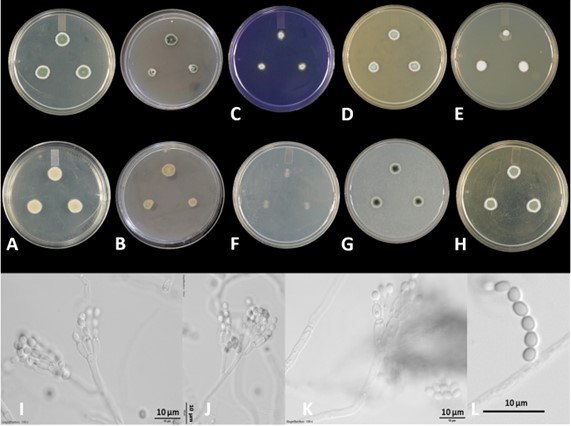Penicillium steckii K.W. Zaleski, Bull. Int. Acad. Polon. Sci., Ser. B., Sci. Nat.1927: 469 (1927).
MycoBank number: MB 278769; Index Fungorum number: IF 278769; Facesoffungi number: FoF 11348;
≡ Penicillium corylophiloides S. Abe, J. gen. appl. Microbiol, Tokyo 2: 89 (1956)
Description
Culture characteristics: Colonies growing after 5 days at 25 ± 2 ºC on following agar media: CYA colonies slow-growing, umbonate, cottony, 2-4 mm in diam.; margins irregular; sporulation white; exudates colourless; soluble pigments absent; reverse wrinkled, cream. MEA colonies slow-growing, radially sulcate, velutinous, umbonate, powdery, mycelia pale green or greyish-green (25B3), 19 mm in diam.; margins regular; sporulation white, dark green (27F6) between mycelia and sporulation; exudate absent; soluble pigment absent; reverse wrinkled, mycelia ivory/natural/platinum blonde sand (4B3), sporulation white. CYAS colonies slow-growing, floccose, umbonate, cottony, mycelia pastel green (25A4), 9 mm in diam.; margin irregular; sporulation greenish-white (25A2); exudate absent; soluble pigment absent; reverse wrinkled, mycelia dark green (30F8), sporulation pale orange (6A3). OA colonies medium growing, flat, granular, powdery, mycelium grey (29E4), 12 mm in diam.; margins regular; sporulation white, greyish green (29E4) in between mycelia and sporulation; exudates colourless; soluble pigment absent; reverse mycelia greyish green, white sporulation (29A1). CZ colonies slow-growing, flat, granular, mycelium white (1A1), 13 mm in diam.; margins irregular; exudate absent; soluble pigment absent; reverse white (1A1). DG18 colonies slow-growing, flat, cottony, suppressed, mycelium white (1A1), 7–9 mm in diam.; margin regular; exudates absent; soluble pigments absent; reverse white (1A1). YES colonies medium growing, floccose, radially sulcate, umbonate, cottony, mycelium dull green (29E3), 10–11 mm in diam.; margins irregular; sporulation white and greenish-grey (27C2) in mycelia and sporulation; exudate absent; soluble pigment absent; reverse wrinkled, mycelia dull green (27E4) to white, sporulation pale yellow. CREA colonies slow-growing, flat, powdery, mycelia greenish-white (26A2), pastel green (26B4) towards mycelia,8–10 mm in diam.; margin irregular; sporulation white; acid production present, soluble pigment, pale yellow(3A3); reverse wrinkled, radiate, white sporulation (1A1), mycelia and sporulation, maize yellow (4A6) and olive-brown (4D4). Conidiophores arising from mycelium mat, predominant symmetrically biverticillate, terverticillate structures abundantly produced in fresh isolates; stipes smooth, width 2.0–3.0µm; metulae in whorls of 2–4, 12−16 × 2.0−2.7μm; phialides ampulliform, 7.5−10×2.0−2.5μm; conidia smooth walled, globose to subglobose, 2.0−2.5×1.8−2.5μm.
Material examined: INDIA, Maharashtra, Pune (18°31′47″N, 73°48′59″E) from soil sample, 12 September 2018, Rajeshkumar K.C., Nikhil Ashtekar (NFCCI 5065).
Distribution: Japan, Netherlands, Panama, Venezuela, Bermuda, Egypt, Venezuela, Indonesia and Slovenia
Sequence data from this collection: ITS: OK345037 (ITS5/ITS4); BenA: OL652649 (Bt2a/Bt2b); CaM: OM948804 (CMD5/CMD6); RPB2: NA (fRPB2-5F/fRPB2-7CR)
Notes: The concatenated phylogenetic analyses of ITS, BenA, CaM, and RPB2 genes showed that our isolate (NFCCI 5065) clustered with the type stain, P. steckii (CBS26055) with a bootstrap value of 100%. Further, both strains share the same morphological characters such as bi to terverticillate conidiophore branching with globose to subglobose conidia with a smooth ornamentation. Hence, we confirm that our collection (NFCCI 5065) is P. steckii based on the morphological characters and phylogenetic analyses and this is the first report of this species from India.
Importance of species to humans or ecosystem: There is no record of any threat to humans or ecosystem
Quarantine significance: No data available regarding quarantine. Fungi belonging to BS level I
Biochemical importance, chemical diversity or application: Houbraken et al. (2010) reported the presence of extrolites Isochromantoxins, quinolactacin, and tanzawaic acids E and F.

Fig. 1. Penicillium steckii. A, B Colonies after 5d at 25± 2 ºC on CYA and MEA obverse and reverse. C CREA obverse. D CYAS obverse. E CZA obverse. F DG18 obverse. G OA (natural) obverse. H YES obverse. I-K biverticillate conidiophore. L Conidia. Scale bar: I-L=10 μm.
